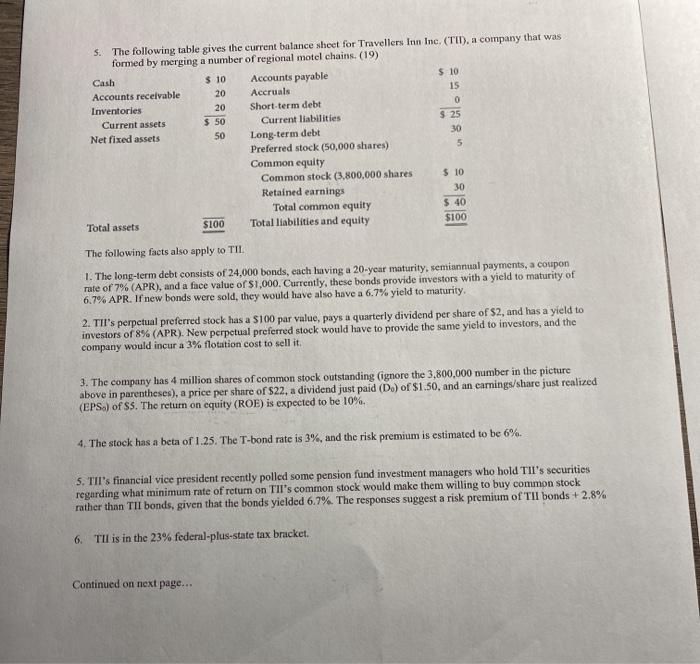5. The following table gives the current balance sheet for Travellers Inn Inc. (TID), a company that was formed by merging a number of regional motel chains. (19) Cash $ 10 Accounts payable $ 10 20 Accounts receivable 15 Accruals Inventories 20 Short-term debt 0 Current assets $50 Current liabilities $ 25 Net fixed assets 50 Long-term debt 30 Preferred stock (50,000 shares) 5 Common equity Common stock (3.800,000 shares $ 10 Retained earnings 30 Total common equity $ 40 $100 Total assets $100 Total liabilities and equity The following facts also apply to TIL 1. The long-term debt consists of 24,000 bonds, each having a 20-year maturity, semiannual payments, a coupon rate of 7% (APR), and a face value of $1,000. Currently, these bonds provide investors with a yield to maturity of 6.7% APR. If new bonds were sold, they would have also have a 6.7% yield to maturity. 2. Til's perpctual preferred stock has a $100 par value, pays a quarterly dividend per share of S2, and has a yield to investors of 8% (APR). New perpetual preferred stock would have to provide the same yield to investors, and the company would incur a 3% flotation cost to sell it. 3. The company has 4 million shares of common stock outstanding (ignore the 3,800,000 number in the picture above in parentheses), a price per share of $22, a dividend just paid (D) of $1.50, and an earnings/share just realized (EPS) of SS. The return on cquity (ROE) is expected to be 10%. 4. The stock has a beta of 1.25. The T-bond rate is 3%, and the risk premium is estimated to be 6%. 5. Til's financial vice president recently polled some pension fund investment managers who hold Til's securities regarding what minimum rate of return on Til's common stock would make them willing to buy common stock rather than TIl bonds, given that the bonds yielded 6.7%. The responses suggest a risk premium of Til bonds +2.8% 6. Til is in the 23% federal-plus-state tax bracket. Continued on next page... Assume that you were recently hired by Tll as a financial analyst and that your boss, the treasurer, has asked you to estimate the company's WACC under the assumption that no new equity will be issued. Your cost of capital should be appropriate for use in evaluating projects that are in the same risk class as the assets TI now operates. Based on your analysis, answer the following questions A. What are the current market value weights for debt, preferred stock, and common stock? (Hint: Do your work in dollars, not millions of dollars. When you calculate the market values of debt and preferred stock, be sure to round the market price per bond and the market price per share of preferred to the nearest penny) B. What is the after-tax cost of debt? C. What is the cost of (new) preferred stock? D. What is the required return on common stock using CAPM? E. Use the retention growth equation to estimate the expected growth rate. Then use the expected growth rate and the dividend growth model to estimate the required return on common stock F. What is the required return on common stock using the own-bond-yield-plus-judgmental-risk-premium approach? G. Use the average of your answers to parts D, E, and F to provide a final cost of common equity estimate. And use this average estimate of common equity cost to provide a final estimate for TIL'S WACC Valve debt: 24.000X160 524,00,300 value of dubt = 24, 787,000 Half Coulon :3.5% Half view to many = 3.35% Pv @3.35% for Hoyes = 21.861 Pv for maturity = 0.268 Interest = 840,000 Poraple=240.90 840,000x 21.26 = 18,36 3,240 24.00908 4.268 = 6,423,80 Value preferred stock: 100-3 397 Per Peserved (55,000 X97) = 4,850,000 Value Common Stock: 40,000,000 Sheres 422 = (88.00902 Couston = 70 761-123) = (5.39% c) cost of new Preferred stock? Crocic = 100-3=47 DIV (734) = 8 =8.25% 47X100 Need e, f, g









